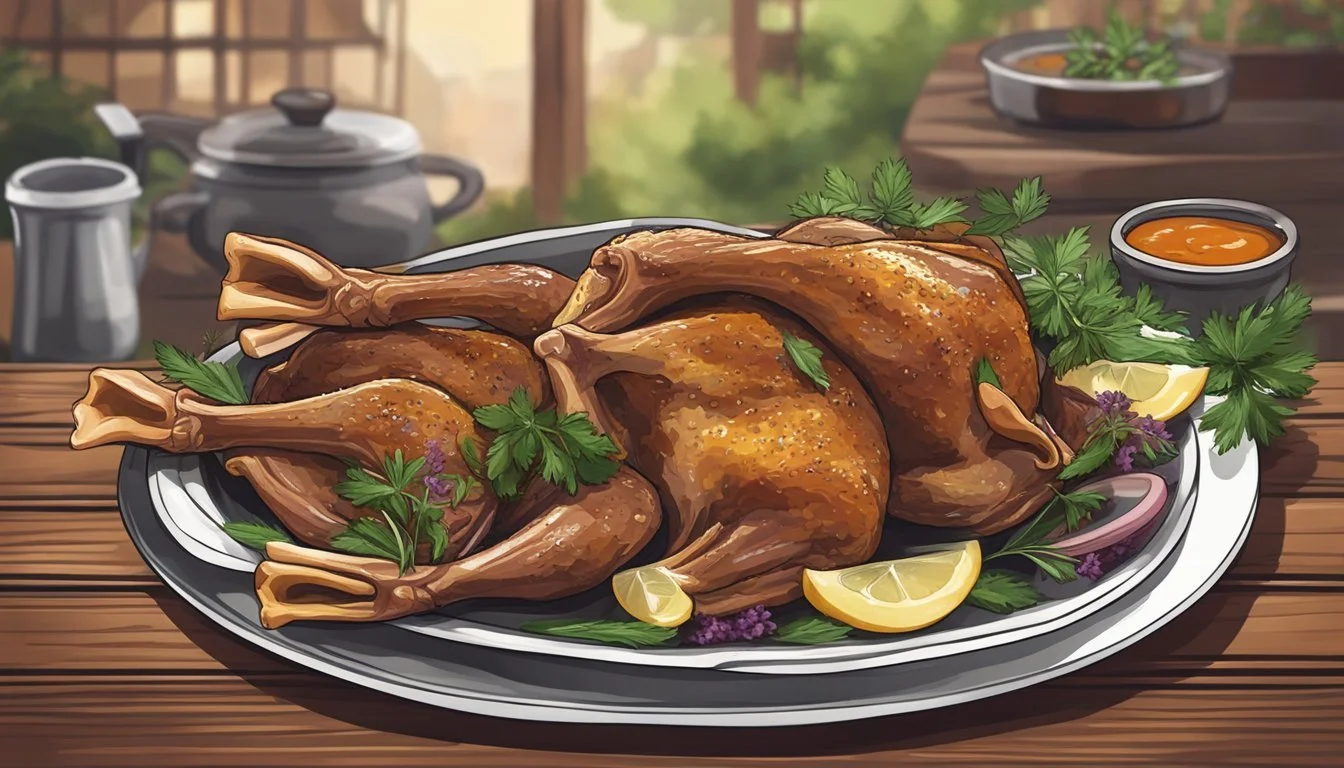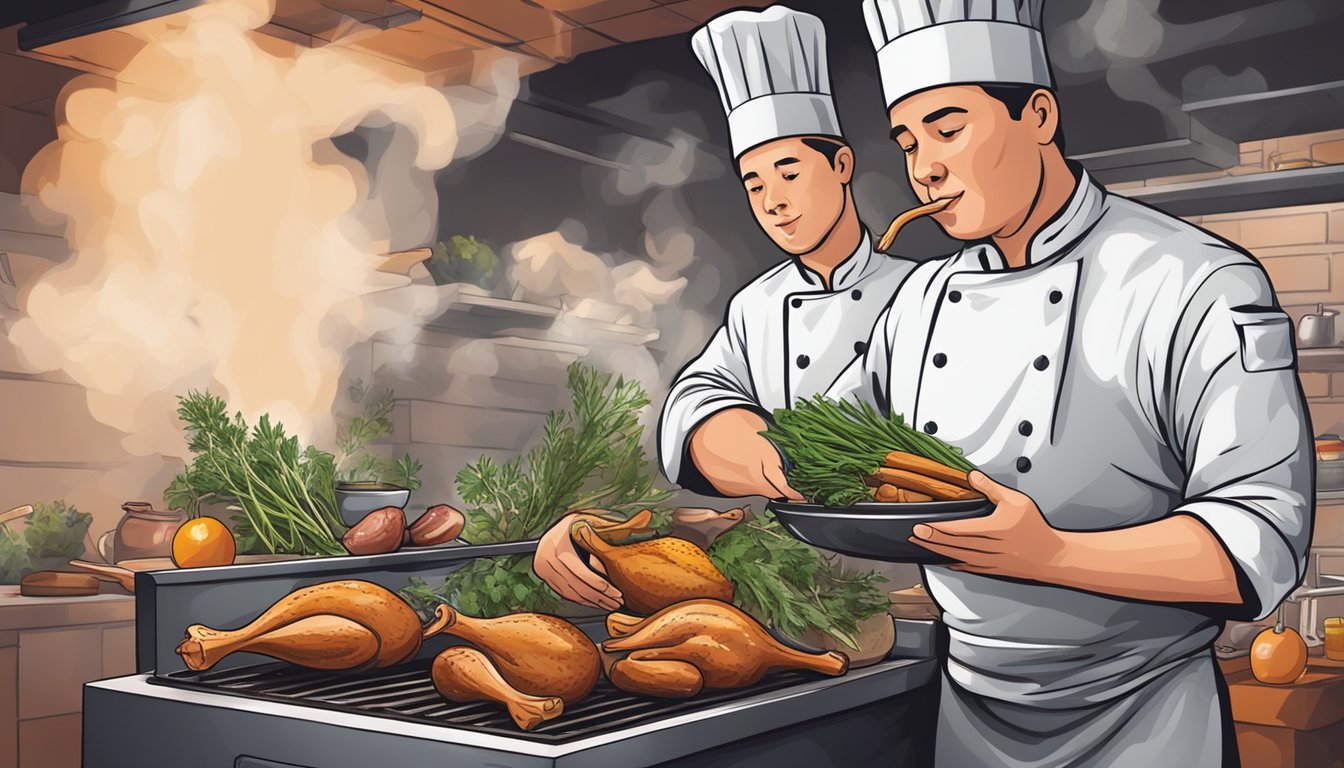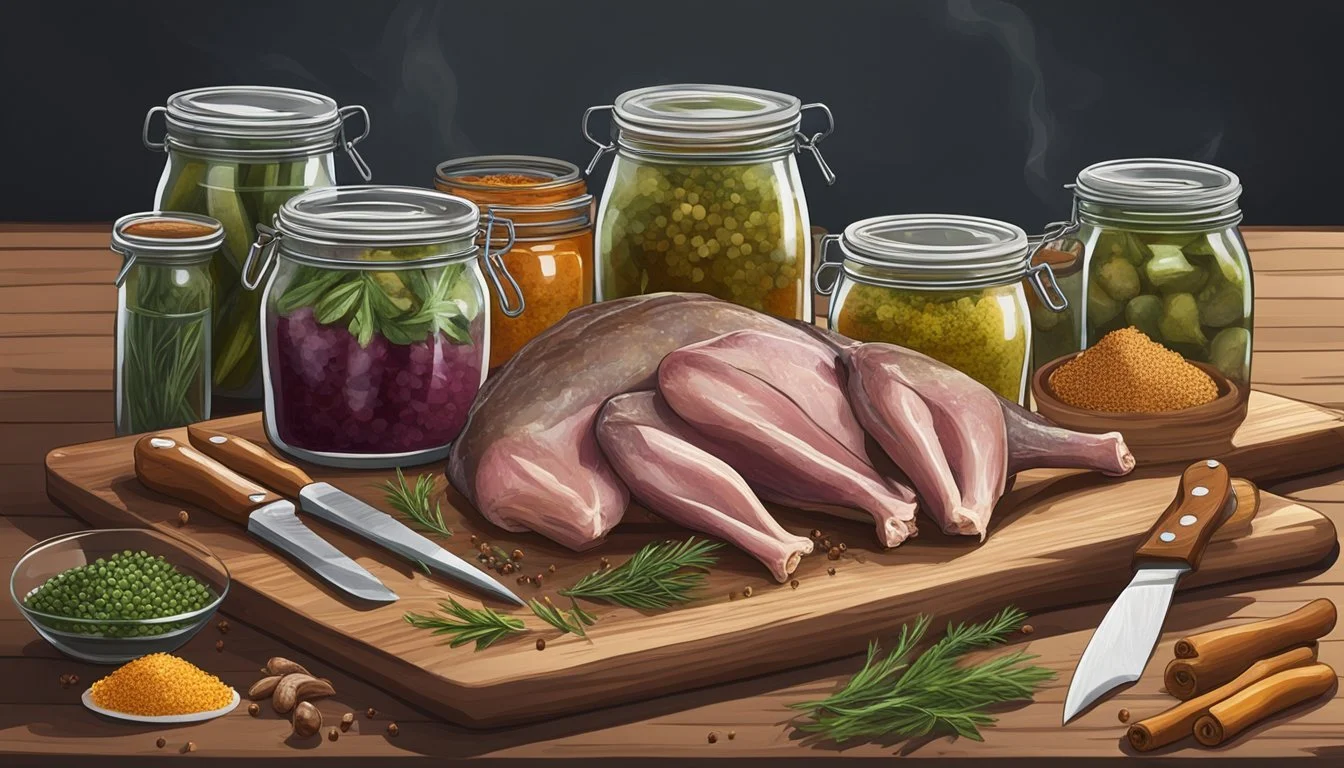Smoked Duck Legs
A Delicious DIY Recipe for Home-Cooked Elegance
Smoking meats is an age-old technique that brings out rich, deep flavors and tenderizes the meat in a way that other cooking methods cannot match. Smoked duck legs, in particular, are a delicacy that combines the succulent taste of duck with the complex aromas created by the smoking process. Duck legs have a naturally high-fat content that renders down during smoking, crisping the skin and infusing the meat with a mix of smokiness and the duck's own rich flavors.
When it comes to home cooking, crafting the perfect smoked duck leg is both an art and a science. It requires attention to detail, starting with a dry rub or brining step to properly season the meat. The smoking temperature and time are crucial variables, with most recipes recommending a low and slow approach to ensure the duck legs are cooked thoroughly without losing their moisture. Wood choice, too, plays a significant role in the final taste of the smoked duck; applewood, for example, imparts a subtly sweet undertone that complements the richness of the duck.
Preparing smoked duck legs at home is a rewarding endeavor for any culinary enthusiast looking to expand their repertoire. It's an opportunity to explore the nuanced interplay of flavors and textures that high-quality smoked meats can offer. Whether enjoyed as the centerpiece of a meal or as an addition to a charcuterie board, smoked duck legs present a sumptuous option for those who appreciate the craftsmanship involved in traditional smoking methods.
Understanding Duck Meat
In this section, we explore the distinct attributes of duck meat, focusing particularly on the characteristics of duck legs compared with breast meat.
Duck Legs vs. Breast Meat
Duck legs are located on the lower part of the duck and are known for their rich flavor and succulent texture. They are generally smaller and have more connective tissue than breast meat, which makes them well-suited for slow-cooking methods like smoking. Duck breast, on the other hand, is the leaner cut of the two and is often preferred for quick-cooking methods. It's prized for its tenderness and the delicious layer of fat that renders down during cooking.
Dark Meat Characteristics
Duck legs are classified as dark meat, and this type of meat is darker in color because it comes from muscles that are used more frequently by the duck, resulting in a higher concentration of myoglobin. Dark meat is:
Richer in flavor: Dark meat has a more intense and robust taste compared to white meat due to its fat content and muscle usage.
Juicier texture: The presence of fat and connective tissues make the legs naturally moister.
Nutrient-dense: Duck meat provides a good source of iron, niacin, selenium, and vitamins, such as A, E, K, and B vitamins.
In summary, duck legs offer a unique culinary experience with their concentrated flavor and tender texture, making them a suitable choice for smoking and other long, slow cooking methods.
Ingredients and Equipment
In creating succulent smoked duck legs, one must carefully select quality ingredients and utilize the proper equipment. This will ensure not only flavorful meat but also the ideal texture and juiciness.
Choosing the Right Duck Legs
Selecting high-quality duck legs is crucial for a delectable outcome. One should look for legs with a good proportion of meat to fat, as duck fat aids in keeping the meat tender during the smoking process. Opt for fresh over frozen when available, ensuring the skin is intact, which helps hold in moisture and flavor.
Essential Spices and Herbs
A balanced dry brine is key to seasoning the duck legs. It typically includes:
Kosher salt: Enhances flavor and aids in moisture retention.
Black pepper: Adds a subtle heat and sharpness.
Garlic powder: Provides a savory note.
Fresh thyme and rosemary: These herbs infuse the meat with aromatic flavors.
To create the brine, mix these ingredients thoroughly before applying them to the duck.
Required Smoking Equipment
The right equipment will make or break the smoking process. For smoking duck legs, one will need:
A reliable smoker or charcoal grill capable of maintaining a consistent temperature.
A knife to score the duck skin, which helps render the fat.
Cooling racks, to place the duck on during the seasoning and smoking processes to allow for airflow.
Ensure that all equipment is clean and in good working order before commencing.
Selecting Wood Chips for Flavor
The type of wood chips used for smoking will significantly influence the flavor of the duck. Maple wood chips are preferred for their subtle sweetness that complements the richness of the duck. Other fruit woods like apple or cherry can also be used for a lighter, fruitier essence. Typically, one should avoid overpowering flavors such as mesquite that can overshadow the delicate taste of the meat.
Preparing the Duck Legs
Preparing the duck legs for smoking involves careful skin treatment to ensure proper rendering of fat, creating a well-balanced dry brine, and thoroughly applying it to the meat. These initial steps are crucial in achieving the perfect flavor and texture in smoked duck legs.
Duck Skin Treatment
The duck legs need to have skin that is primed for smoking to allow the fat to render properly. One should begin by trimming any excess skin that might prevent even cooking. Next, using a sharp knife, gently pierce the skin all over. This step is vital as it helps in the rendering process and allows for crispier skin.
Creating the Dry Brine
A dry brine is used to season the duck and help retain moisture during smoking. The brine consists of a mix of:
Kosher salt (essential for drawing moisture out)
Black pepper (for a robust flavor)
Bay leaves (crushed to release aroma)
Garlic powder (to add depth)
Combine these ingredients in equal proportions to ensure each duck leg is coated with the same flavor profile. If preferred, one can adjust quantities to taste, keeping in mind that the salt is pivotal for both seasoning and moisture control.
Applying the Dry Brine
Application of the dry brine should be thorough to cover all parts of the duck legs. Lay the legs skin-side up on a cutting board and sprinkle the dry brine over the front and back, pressing gently to adhere. Once the legs are fully coated, they should be transferred to a refrigerator. The duck legs must rest for at least 2 hours, or overnight for the brine to penetrate and moisture to be appropriately drawn out from the flesh, enhancing the overall flavor and texture.
Smoking Process
The smoking process is critical to ensuring your duck legs are flavorful and tender. It involves a combination of pre-smoking preparations, precise temperature control, and careful monitoring of internal temperature.
Pre-Smoking Preparations
Before smoking the duck legs, it's essential to properly prepare them. One should start by patting the duck legs dry with paper towels to remove excess moisture, which helps the skin get crisp during smoking. Applying a dry rub evenly across the legs can enhance flavor. Allow the rubbed duck legs to sit in the refrigerator for at least 2 hours to absorb the seasonings. Meanwhile, prepare the smoker by filling it with the desired wood chips—fruit woods like cherry or apple can impart a mild, sweet smoke that complements duck.
Smoking Temperature and Time
One should preheat their smoker to a stable 225 degrees F before introducing the duck legs. Smoking at this temperature allows the duck fat to slowly render without drying out the meat. The legs should be placed skin-side up on the grate to expose them to indirect grilling—a method that cooks the meat using the surrounding hot air, rather than direct heat from the flames. The overall smoking time is usually around 3 hours, but one should always cook to temperature, not strictly by time.
Monitoring Internal Temperature
During the smoking process, it's crucial to monitor the internal temperature of the duck legs. A meat thermometer is an invaluable tool for this task. The duck is done when it reaches an internal temperature of 165 degrees F. One should check the temperature at the thickest part of the leg without touching the bone, which can give a false reading. By keeping an eye on the internal temperature, one ensures that the smoked duck legs will be safe to eat and perfectly cooked, with tender meat and a crispy skin.
Finishing Techniques
After smoking, finishing techniques are imperative for achieving the perfect texture and enhancing the flavor of duck legs. Utilizing either an oven or grill can confer distinct character to the final dish.
Oven Finishing for Crispy Skin
When the goal is to attain crispy skin on smoked duck legs, using an oven is an efficacious method. The chef should preheat the oven to a high temperature, typically 400°F (200°C). They then place the smoked duck legs on a wire rack over a baking sheet to allow heat circulation. The duck legs are roasted for approximately 10-15 minutes or until the skin reaches the desired level of crispiness.
Grill Finishing for Additional Flavor
For those desiring an extra infusion of flavor, finishing duck legs on a grill is advisable. The chef should preheat the grill to a medium-high heat. The duck legs are then placed skin-side down directly on the grill grates. This technique not only imparts a smoky char but also preserves the tenderness of the meat. Grilling should be done attentively for a few minutes until the skin crisps up and exhibits grill marks, ensuring that the duck legs do not burn.
Serving Suggestions
After meticulously preparing your smoked duck legs, serving them in a manner that accentuates their succulence is essential. This section provides guidance on resting and carving, recommended pairings, and presentation tips to ensure a memorable meal.
Resting and Carving the Duck Legs
Prior to serving, the duck legs should rest for about 10 minutes to allow the juices to redistribute, ensuring each bite is tender and flavorful. Carve the duck by separating the meat from the bone with a sharp knife, slicing it into thin pieces for ease of eating.
Accompaniments and Pairings
When it comes to selecting accompaniments, the rich flavor of smoked duck pairs exquisitely with a variety of side dishes:
Vegetables: Roasted carrots, onions, and celery complement the smokiness of duck and add a vibrant array of colors to your plate.
Sauces: A glaze made from red wine and brown sugar can add a lovely sweetness that balances the savory duck.
Starches: Serve with a wild rice pilaf or a black bean, corn, and rice salad for a delightful textural contrast.
Presentation on the Serving Platter
Careful presentation on the serving platter can transform a simple meal into an elegant dining experience:
Arrange carved duck legs on a large platter.
Intersperse the duck with roasted vegetables creating a pattern that pleases the eye.
Drizzle the sauce or glaze across the duck pieces for a glossy finish.
Advanced Tips and Variations
Mastering the art of smoking duck legs unlocks a multitude of flavors and textures one can experiment with through glazes, sauces, and various smoking techniques.
Experimenting with Glazes and Sauces
Adding glazes and sauces to smoked duck legs can elevate the dish to new culinary heights. They should consider the timing of application; a glaze can be brushed on during the last 30 minutes of smoking to ensure it caramelizes without burning. Sauces, on the other hand, may be served on the side or drizzled over just before serving to enhance moisture and flavor. They could try a sauce rich in iron, such as one incorporating a balsamic reduction, to complement the duck's natural nutrients.
Classic Orange Glaze: A sweet and tangy blend of orange juice, honey, and a touch of ginger.
Spicy BBQ Sauce: A bold mix of tomato sauce, Worcestershire, brown sugar, and chili flakes.
Alternative Smoking Techniques
They can further refine their smoked duck legs by exploring different smoking techniques. For those seeking a tender and flavorful meat, they may consider braising smoked duck legs in a stock after smoking, infusing them with additional moisture and taste. This involves partially submerging the legs in a liquid such as chicken or duck stock, and then slow-cooking in a covered BBQ or oven.
Pre-Smoke Scoring: Prior to smoking, they should score the skin to help render out the fat and achieve a crisper texture.
Flipping Frequency: While smoking, minimize flipping. It's typically unnecessary and may cause the meat to lose precious juices.
By incorporating these advanced tips and variations into their method, they can create unique and memorable dishes tailored to their particular taste preferences.
Storage and Leftovers
Proper storage maximizes the shelf life of smoked duck legs, and the rich flavor of leftovers offers versatility for creating new dishes. Here’s how to preserve the taste and quality of your smoked duck either in the refrigerator or through innovative recipes.
Refrigerating Smoked Duck Legs
Smoked duck legs can be stored in the refrigerator for up to four days. To retain their moisture and flavor, one should:
Cool the duck legs to room temperature within two hours of cooking to prevent bacteria growth.
Wrap the legs individually in plastic wrap or aluminum foil. This preserves the quality and prevents the duck fat from picking up other flavors in the fridge.
Place the wrapped duck legs in an airtight container to further protect them from contaminants.
Recipes for Leftover Duck
Leftover smoked duck legs are incredibly versatile and valuable for creating new dishes. One can incorporate the duck into various meals as one would with braised duck or pulled pork. Here are a couple of suggestions:
Smoked Duck Salad: Shred the smoked duck and serve it with fresh greens, a vinaigrette, and sprinkle over some duck fat to enrich the flavor.
Duck Pasta: Use the duck in place of traditional proteins like pulled pork in pasta dishes. Combine with pappardelle noodles, parmesan, and your choice of sauce for an indulgent meal.
When handled correctly, leftover smoked duck can be a culinary asset, turning simple ingredients into gourmet meals.







